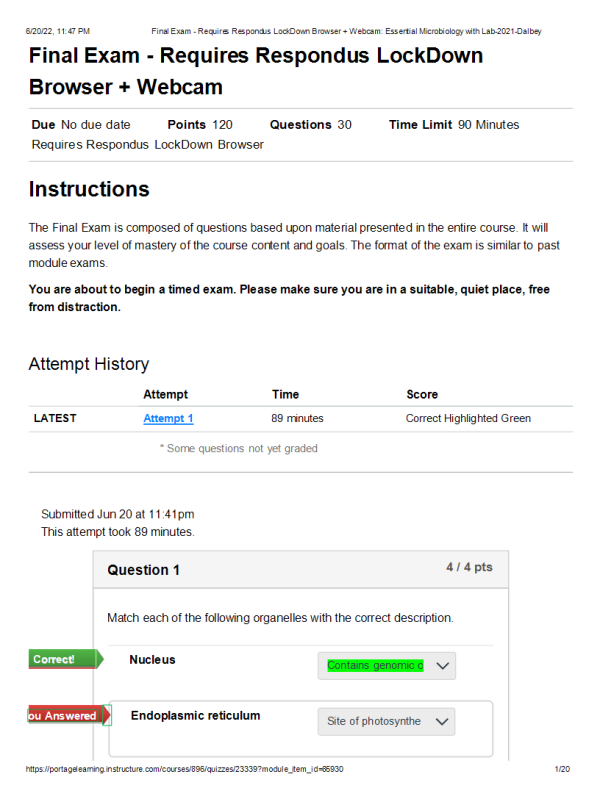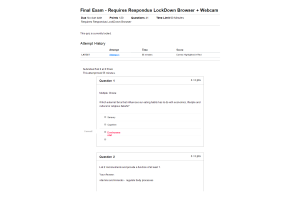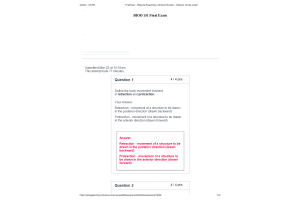BIOD 171 Final Exam
Course : BIOD 171 Essential Microbiology with Lab
Contributed : Egreta Ston
- $35.00
- Question: Match each of the following organelles with the correct description.
- Question: Briefly explain how a Scanning Electron Microscope (SEM) forms an image of subcellular organelles, substrates, and viral particles.
- Question: Match each of the following diseases to the correct bacterial family.
- Question: Identify each of the following microorganisms as either a Prokaryote or a Eukaryote.
- Question: Match each of the following terms with the correct description.
- Question: A researcher is looking to determine the source of contamination of a patient that presented with symptoms of food poisoning. To best determine between E. coli or Salmonella as the cause, what type of agar will be used to isolate the growth of each?
- Question: Place the following viral life cycle steps in order beginning with viral attachment (3points) and provide a description of “ENTRY” (1 point).
- Question: The Gram stain differentiates between bacteria based on the composition of their .
- Question: Left untreated, three percent of cases of Streptococcal pharyngitis will progress to which of the following?
- Question: Describe TWO differences between DNA and RNA
- Question: When grown on Blood Agar Plates (BAP), microbes capable of alpha hemolysis present as greenish-brown color colonies due to incomplete (partial) lysis of red blood cells.
- Question: Each of the following statements about glycolysis is true, except:
- Question: Describe the ONE main differences between lytic and temperate phages.
- Question: Bacteria that have a curved rod morphology are referred to as .
- Question: You want to observe the movement of microorganisms that are present in a sample of cheek cells obtained on a patient. Briefly explain the technique that you would use and how it is performed.
- Question: What coronavirus-associated infection gave rise to quarantining and travel restrictions in 2003?
- Question: Match each type of agar plate to the corresponding general characteristics of each.
- Question: Leprosy can move through the blood to other areas including the brain, spine, and kidneys.
- Question: Proteins can function to catalyze biochemical processes and play a role in structure, but they cannot enable movement.
- Question: You are working with a patient who claims a friend “got the COVID-19 infection from the vaccine”. Explain why the viral vector vaccine used to prevent the COVID-19 infection cannot transmit the actual infection.
- Question: Match each type of microscopy with the correct description.
- Question: Which of the following reactions is an example of a hydrolase?
- Question: Which region in a four phase dilutional streak contains the highest concentration of a microbial organism? Describe the technique that is used in pulling the sample from one phase to the next
- Question: Identify the following disease based upon the physical manifestation:
- Question: Which of the following is/are true of Animalia? (Select all that apply)
- Question: Each of the following statements about measles, mumps, and rubella is true, except:
- Question: There has been an outbreak of Staph Aureus within a local cleaning business. The employer Is trying to determine which of two companies has not been using sterile precautions when cleaning. To help determine who is responsible for unsanitary practices, a researcher streaks the isolated bacterial samples from each company onto MSA agar. After incubating the samples overnight at 37°C., briefly explain how he will interpret the result of his samples
- Question: The metabolism of a lipid-derived carbon atom will yield more ATP than a molecule of glucose.
- Question: Giemsa staining is used to detect each of the following, except:
- Question: What STD is caused by Gram-negative, diplococci, fastidious bacteria that may result in cardiac and neurological complications?



